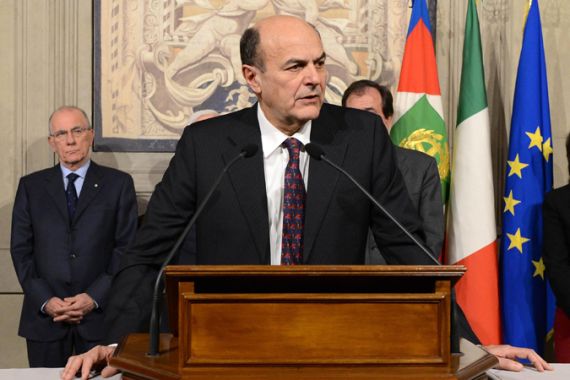Berlusconi offers coalition with centre-left
Former Italian prime minister says he is willing to support a coalition, but rejects a technocratic government.

Former Italian prime minister Silvio Berlusconi said on Friday he was ready to support a coalition government with centre-left leader Pier Luigi Bersani, but rejected another technocrat administration like the outgoing one led by Mario Monti.
“Our position has not changed, we expressed it with absolute clarity to the president,” centre-right leader Berlusconi told reporters after meeting president Giorgio Napolitano.
He said he believed there was room for agreement on a series of measures to address Italy’s economic crisis but insisted that any government must be made up of political parties “given the tragic experience” of the Monti government.
Roberto Maroni, leader of Berlusconi’s Northern League ally, also rejected another technocrat government, saying it would be better to go hold another election, after a vote in February that left the country deadlocked.
His announcement comes as Napolitano is meeting political leaders to try to break a month-old stalemate after general elections left no party with enough seats to be able to form a government.
The deadlock in Italy, the eurozone’s third largest economy, comes as the Cyprus banking crisis has revived fears of renewed financial market turmoil that could threaten the stability of the currency bloc.
After five days of talks, Bersani has failed to secure a deal with either former prime minister Silvio Berlusconi’s centre-right bloc, the second-largest force in parliament, or former comic Beppe Grillo’s anti-establishment 5-Star Movement, which holds the balance of power.
Possible downgrade?
The centre-left leader rejected Berlusconi’s demand that he be allowed to decide Napolitano’s successor as head of the state, and Grillo’s populist group maintained its refusal to support a government led by any of the big parties it blames for Italy’s social and economic crisis.
Napolitano’s options now include appointing a figure from outside politics to lead a technocrat government like that of outgoing prime minister Mario Monti, or a cross-party alliance backed by the big parties.
Among possible candidates are Fabrizio Saccomanni, the widely respected director general of the Bank of Italy, the head of the constitutional court Franco Gallo or former prime minister Giuliano Amato.
The political gridlock has fed growing worries about Italy’s ability to confront a prolonged economic crisis that has left it in deep recession for more than a year, with massive public debt and record unemployment, especially among the young.
Rumours have been circulating for days that ratings agency Moody’s is preparing to cut its rating on Italy’s sovereign debt, which is already only two notches above “junk” grade, partly due to the uncertain political outlook.
The immediate pressure from the bond markets has been taken off during the Easter break, but failure to make progress in securing an agreement could lead to new turbulence next week after a steady rise in Italy’s borrowing costs in recent days.
But the prospects appear slim of appointing the kind of government capable of turning around an economy that has been in decline for more than a decade, with deep-rooted problems ranging from corruption to suffocating bureaucracy.